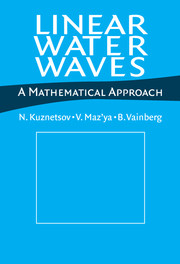Book contents
8 - Two-Dimensional Problem for a Surface-Piercing Body
from 2 - Ship Waves on Calm Water
Published online by Cambridge University Press: 14 October 2009
Summary
This chapter is concerned with various statements of the two-dimensional Neumann-Kelvin problem for a surface-piercing body. We speak about various statements because the Neumann–Kelvin problem as it is formulated in Chapter 7 for totally submerged bodies proves to be under definite when a body is surface piercing. It took several decades to realize that this under-definiteness occurs and to develop several well-posed formulations of the problem (see a brief consideration of the question's history in Section 8.6).
The plan of this chapter is as follows. The problem augmented by general linear supplementary conditions is considered in Section 8.1. The question of total resistance to the forward motion for a surface-piercing cylinder is considered in a short Section 8.2, where we present formulae generalizing those in Section 7.3. A number of other statements of the Neumann–Kelvin problem are reviewed in Section 8.3. Among them, there are statements leading to the so-called least singular and wave-free solutions. Also, a statement of the Neumann–Kelvin problem for a tandem of surface-piercing cylinders is considered. This statement involves a set of four supplementary conditions canceling both the wave resistance and the spray resistance and providing a well-posed statement of the problem. This means that a unique solution exists for all values of the forward speed U except for a sequence tending to zero.
At the same time, for the exceptional values of U, examples of non-uniqueness are constructed in Section 8.4.
- Type
- Chapter
- Information
- Linear Water WavesA Mathematical Approach, pp. 361 - 418Publisher: Cambridge University PressPrint publication year: 2002



